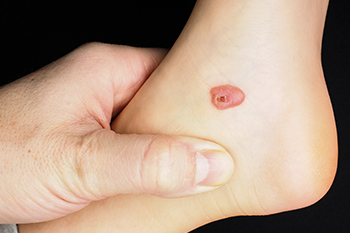
Blood blisters on the feet and toes can result from various factors, including sustained pressure or friction on the skin without breaking the skin’s surface. This is common in activities like running, dancing, or wearing ill-fitting shoes. Blood blisters look like friction blisters, but are filled with blood instead of clear fluid. They may appear red, purple, or black. While blood blisters may look scary, they are generally common and not usually a cause for alarm. Treatment typically involves allowing the blister to heal naturally over one to two weeks, with the formation of new skin beneath the blister. It's essential to protect the blister during this time, possibly by applying a bandage or similar protective covering. Prevention strategies to avoid developing blood blisters on the feet or toes include well-fitting footwear, protective gear during activities, and moisture-wicking socks to reduce sweat and friction. If the blood blister becomes painful or shows signs of infection, it is suggested that you make an immediate appointment with a podiatrist.
Blisters are prone to making everyday activities extremely uncomfortable. If your feet are hurting, contact Jack A. Sasiene, DPM of Texas. Our doctor can provide the care you need to keep you pain-free and on your feet.
Foot Blisters
Foot blisters develop as a result of constantly wearing tight or ill-fitting footwear. This happens due to the constant rubbing from the shoe, which can often lead to pain.
What Are Foot Blisters?
A foot blister is a small fluid-filled pocket that forms on the upper-most layer of the skin. Blisters are filled with clear fluid and can lead to blood drainage or pus if the area becomes infected.
How Do Blisters Form?
Blisters on the feet are often the result of constant friction of skin and material, usually by shoe rubbing. Walking in sandals, boots, or shoes that don’t fit properly for long periods of time can result in a blister. Having consistent foot moisture and humidity can easily lead to blister formation.
Prevention & Treatment
It is important to properly care for the affected area in order to prevent infection and ease the pain. Do not lance the blister and use a Band-Aid to provide pain relief. Also, be sure to keep your feet dry and wear proper fitting shoes. If you see blood or pus in a blister, seek assistance from a podiatrist.
If you have any questions, please feel free to contact our office located in Lake Jackson, TX . We offer the newest diagnostic and treatment technologies for all your foot care needs.
